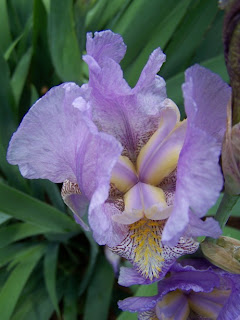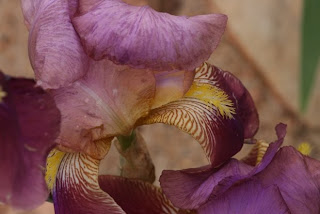A co-worker got married last weekend and asked me to take some pictures of the wedding party in a nearby park. Naturally I went early and browsed around to see what pictures I could get for my blog and the variety of Irises caught my eye.

With hundreds of varieties in several different colors and combinations, Irises are popular and easy to grow perennial. The most common larger varieties are great at the back of the flower bed or as a cutting. For flower growers, there is a place in your garden for one, or several groups. But, be careful, as they spread quickly and can overcome other flowers.

Irises are grown from both seed and root separation. The roots, or Rhizomes, are easily separated and replanted. The Rhizome looks like a long, thin potato with roots underneath. When transplanting, separate the Rhizome. Make sure to have some root and a leaf or two in each section. Plant the Rhizomes near the surface with the roots below. Space them a foot or so apart . They will fill in the spaces quickly.

If you want a low maintenance, easy to grow flower, you have come to the right plant. Irises like full sun, but tolerate partial shade well. Their only demand is well draining soil to avoid root rot. The soil does not need to be the richest in your yard. Nor, does it demand heavy fertilizer feeding. Once established, you will need to water them only in the driest part of the year. Fertilize occasionally. Do not apply heavy doses of Nitrogen.

Being a hardy plant, Irises are not often bothered by insects. They can suffer from occasional root borers.

Irises seldom are affected by disease. The most common problem is root rot, which is caused by poorly draining soils. In preparing beds, make sure soil is light and well draining. Raise the soil level if need be. Also add sand, and compost if you have clay soil.
 With hundreds of varieties in several different colors and combinations, Irises are popular and easy to grow perennial. The most common larger varieties are great at the back of the flower bed or as a cutting. For flower growers, there is a place in your garden for one, or several groups. But, be careful, as they spread quickly and can overcome other flowers.
With hundreds of varieties in several different colors and combinations, Irises are popular and easy to grow perennial. The most common larger varieties are great at the back of the flower bed or as a cutting. For flower growers, there is a place in your garden for one, or several groups. But, be careful, as they spread quickly and can overcome other flowers. Irises are grown from both seed and root separation. The roots, or Rhizomes, are easily separated and replanted. The Rhizome looks like a long, thin potato with roots underneath. When transplanting, separate the Rhizome. Make sure to have some root and a leaf or two in each section. Plant the Rhizomes near the surface with the roots below. Space them a foot or so apart . They will fill in the spaces quickly.
Irises are grown from both seed and root separation. The roots, or Rhizomes, are easily separated and replanted. The Rhizome looks like a long, thin potato with roots underneath. When transplanting, separate the Rhizome. Make sure to have some root and a leaf or two in each section. Plant the Rhizomes near the surface with the roots below. Space them a foot or so apart . They will fill in the spaces quickly. If you want a low maintenance, easy to grow flower, you have come to the right plant. Irises like full sun, but tolerate partial shade well. Their only demand is well draining soil to avoid root rot. The soil does not need to be the richest in your yard. Nor, does it demand heavy fertilizer feeding. Once established, you will need to water them only in the driest part of the year. Fertilize occasionally. Do not apply heavy doses of Nitrogen.
If you want a low maintenance, easy to grow flower, you have come to the right plant. Irises like full sun, but tolerate partial shade well. Their only demand is well draining soil to avoid root rot. The soil does not need to be the richest in your yard. Nor, does it demand heavy fertilizer feeding. Once established, you will need to water them only in the driest part of the year. Fertilize occasionally. Do not apply heavy doses of Nitrogen.
